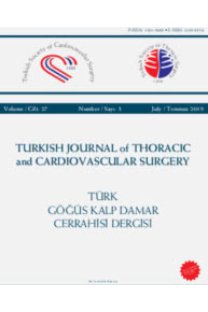Survival in adenosquamous cancer of the lung: is it really so unfavorable?
Akciğerin adenoskuamöz kanserinde sağkalım: Gerçekten o kadar kötü mü?
___
- 1. Gawrychowski J, Brulinski K, Malinowski E, Papla B. Prognosis and survival after radical resection of primary adenosquamous lung carcinoma. Eur J Cardiothorac Surg 2005;27:686-92.
- 2. Maeda H, Matsumura A, Kawabata T, Suito T, Kawashima O, Watanabe T, et al. Adenosquamous carcinoma of the lung: surgical results as compared with squamous cell and adenocarcinoma cases. Eur J Cardiothorac Surg 2012;41:357-61.
- 3. Kamiyoshihara M, Hirai T, Kawashima O, Ishikawa S, Morishita Y, Maeshima A. A clinicopathologic study of the resected cases of adenosquamous carcinoma of the lung. Oncol Rep 1998;5:861-5.
- 4. Hsia JY, Chen CY, Hsu CP, Shai SE, Wang PY. Adenosquamous carcinoma of the lung. Surgical results compared with squamous cell and adenocarcinoma. Scand Cardiovasc J 1999;33:29-32.
- 5. Hofmann HS, Knolle J, Neef H. The adenosquamous lung carcinoma: clinical and pathological characteristics. J Cardiovasc Surg (Torino) 1994;35:543-7.
- 6. Nakagawa K, Yasumitu T, Fukuhara K, Shiono H, Kikui M. Poor prognosis after lung resection for patients with adenosquamous carcinoma of the lung. Ann Thorac Surg 2003;75:1740-4.
- 7. Travis WD, Brambilla E, Muller-Hermenlink HK, Harris CC. World Health Organization Classification of Tumors. Pathology and genetics of tumors of the lung, pleura, thymus and heart. Lyon: International Agency for Research on Cancer Press; 2004.
- 8. Shimosato Y. Pulmonary neoplasms. In: Sternberg SS, editor. Diagnostic surgical pathology. Vol. 1. New York: Raven Press; 1989. p. 785-27.
- 9. Ichinose Y, Hara N, Takamori S, Maeda K, Yano T, Ohta M. DNA ploidy pattern of each carcinomatous component in adenosquamous lung carcinoma. Ann Thorac Surg 1993;55:593-6.
- 10. Goldstraw P. IASLC Staging Manual in Thoracic Oncology. Orange Park: Editorial Rx Press; 2009.
- 11. Sridhar KS, Bounassi MJ, Raub W Jr, Richman SP. Clinical features of adenosquamous lung carcinoma in 127 patients. Am Rev Respir Dis 1990;142:19-23.
- 12. Naruke T, Tsuchiya R, Kondo H, Asamura H. Prognosis and survival after resection for bronchogenic carcinoma based on the 1997 TNM-staging classification: the Japanese experience. Ann Thorac Surg 2001;71:1759-64.
- 13. Takamori S, Noguchi M, Morinaga S, Goya T, Tsugane S, Kakegawa T, et al. Clinicopathologic characteristics of adenosquamous carcinoma of the lung. Cancer 1991;67:649-54.
- 14. Cooke DT, Nguyen DV, Yang Y, Chen SL, Yu C, Calhoun RF. Survival comparison of adenosquamous, squamous cell, and adenocarcinoma of the lung after lobectomy. Ann Thorac Surg 2010;90:943-8.
- 15. Mordant P, Grand B, Cazes A, Foucault C, Dujon A, Le Pimpec Barthes F, et al. Adenosquamous carcinoma of the lung: surgical management, pathologic characteristics, and prognostic implications. Ann Thorac Surg 2013;95:1189-95.
- 16. Colby TV, Koss MN, Travis WD. Tumors of the lower respiratory tract. In: Atlas of Tumor Pathology. 3rd ed. Washington: Armed Forces Institute of Pathology; 1995. p. 279-86.
- ISSN: 1301-5680
- Yayın Aralığı: Yılda 4 Sayı
- Başlangıç: 1991
- Yayıncı: Bayçınar Tıbbi Yayıncılık
Pulmoner arterin cerrahi gerektiren edinsel hastalıkları
Muhammet AKYÜZ, Kamil GÜLŞEN, İlhan SANİSOĞLU, Barçın ÖZCEM
Roles of ephrin-B2+ and CD34+ cells in post-angioplasty pericardial patch repair
Liu JINGENG, Liu WEICHAO, Shi GONGNING, He FEI
Özcan GÜR, Orkut GÜÇLÜ, Volkan YÜKSEL, Selami GÜRKAN
A rare cardiovascular finding in two cases with Williams syndrome: recurrent coarctation of aorta
Birgül VARAN, İlkay ERDOĞAN, Mehmet Emre ARI, Murat ÖZKAN
Delirium after open heart surgery
Sema TURAN, Çağıl VURAL, Hakan Volkan ACAR, Tuğba KAVASOĞLU, Mehmet Özcan ERDEMLİ, Kemal KAVASOĞLU
Aortik ark varyasyonlarının klinik önemi üzerine bir değerlendirme
Tevfik GÜNEŞ, Yusuf İzzettin ALİHANOĞLU, Veli ÇITIŞLI, İhsan ALUR
Video-assisted thoracoscopic lobectomy for pulmonary arteriovenous malformation: a case report
Kuthan KAVAKLI, Deniz DOĞAN, Alper GÖZÜBÜYÜK, Hakan IŞIK, Okan KARATAŞ
Levent CANSEVER, Celalettin İbrahim KOCATÜRK, Yaşar SÖNMEZOĞLU, Ümit AYDOĞMUŞ, Servet ÖZDEMİR, Mehmet Ali BEDİRHAN
Adiponectin and leptin polymorphisms in patients with coronary artery disease
Kürşat KARGÜN, Sefa ŞENOL, Mustafa YILDIZ, Murat KARA, Hayrettin TEKÜMİT
